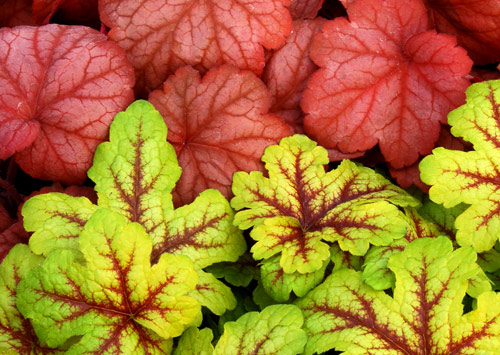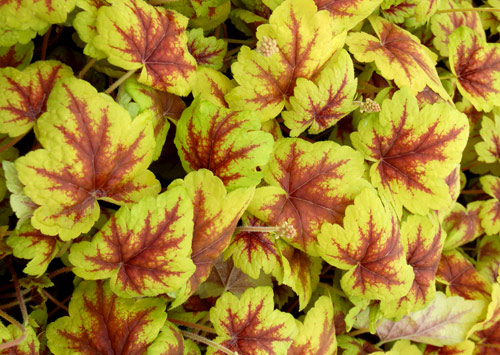A plant breeder is a special person. It's their job to stretch the limits of a plant's capabilities. With Heucherella, our breeders have crossed not 2 species, but 2 genera. By taking Heuchera, with its myriad forms and colors and crossing it to Tiarella, with a palette defined by leaf-shape, growth habit, and dark-centers, a vast array of new hybrids have resulted. Some of the Heuchera seen today can involve 5 separate species (and a hundred cultivars), and the Tiarella can carry the blood of 3 different species. Any math student understanding permutations will cross their eyes to the possibilities these crosses can present.
Enter the Heucherella (hew-ker-ella). There is not much history in this plant. Lemoine started the show by introducing the first cross by the illegitimate name of Heucherella tiarelloides. Much later, Blooms of Bressingham introduced H. 'Bridget Bloom' and Tony Huber from Norseco launched H. 'Rosalie' in 1983. Both were good plants, but lacked a whole lot of interest due to rather mundane crosses. Charles Oliver stepped up the breeding a notch with his superior "Tinian" series, later renamed and promoted by Terra Nova® under the names of H. 'Snow White' and H. 'Pink Frost'. He has continued to introduce new forms.
Starting with H.
'Viking Ship', H. 'Crimson Clouds', H. 'Cinnamon Bear', and
H. 'Cranberry Ice', Terra Nova® tried to break the mold of the "classic"
Heucherella
with vigorous new forms with unusual foliage and improved flowers. Ensuing
plants included H.
'Kimono' which floored visiting Tony Avent when he saw this
yard-wide plant with distinctive leaves in our gardens. The same year
(1999) saw the launch of the hard to beat H.
'Dayglow Pink', a compact plant with masses of flowers.
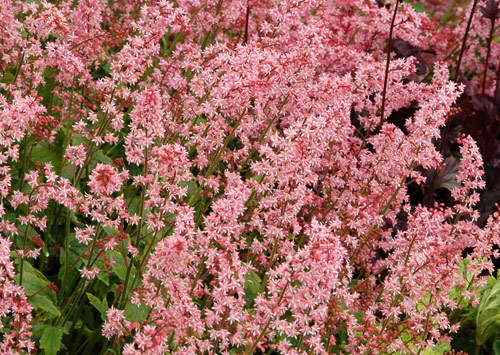 |
| Heucherella 'Viking Ship' |
NEW COLORS
H. 'Burnished Bronze' was a breakthrough with glossy, chocolate brown foliage. We soon followed up with a gold and red tissue culture mutation of H. 'Dayglow Pink' and gave it the name, H. 'Sunspot'. Proven Winners contracted with Terra Nova® in 2004 to produce Terra Nova®'s Heucherella 'Strike it Rich Pink'™ and Heucherella 'Strike it Rich Gold'™, both compact mounding plants.
With the advent of so many new colors in Heuchera, it was not long before Terra Nova® began incorporating these in their crosses. H. 'Stoplight' with its large, red-splashed gold leaves showed a vigor that surpassed H. 'Dayglow Pink' and started a new series of ultra-vigorous, garden-worthy plants. Heucherella 'Alabama Sunrise', not only brought on the new colors, but also introduced Heuchera villosa blood donating more heat and humidity resistance as well as large foliage to the picture. H. 'Tapestry' joined H. 'Alabama Sunrise' in having distinctively cut leaves as well as a unique color combination of near-blue and purple.
TERRA NOVA®'S INTRODUCTIONS:
| Variety Name | Terra Nova® Intro | Year Introduced |
| Heucherella
'Crimson Clouds' |
Y |
1995 |
| Heucherella 'Pink Frost' | - |
1995 |
| Heucherella 'Snow White' | - |
1995 |
| Heucherella 'Silver Streak' | Y |
1997 |
| Heucherella 'Viking Ship' | Y |
1997 |
| Heucherella 'Burnished Bronze' | Y |
1999 |
| Heucherella 'Cinnamon Bear' | Y |
1999 |
| Heucherella 'Cranberry Ice' | Y |
1999 |
| Heucherella 'Dayglow Pink' | Y |
1999 |
| Heucherella 'Kimono' | Y |
1999 |
| Heucherella 'Chocolate Lace' | Y |
2001 |
| Heucherella 'Sunspot' | Y |
2002 |
| Heucherella 'Birthday Cake' | Y |
2004 |
| Heucherella 'Party Time' | Y |
2004 |
| Heucherella 'Strike it Rich Gold'™ | Y |
2004 |
| Heucherella 'Strike it Rich Pink'™ | Y |
2004 |
| Heucherella 'Stoplight' | Y |
2004 |
| Heucherella 'Alabama Sunrise' | Y |
2008 |
| Heucherella 'Tapestry' | Y |
2009 |
| Heucherella 'Sweet Tea' | Y |
2009 |
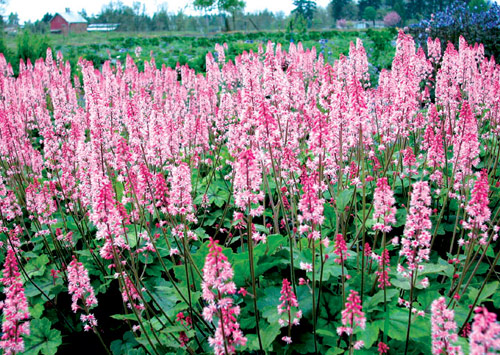
|
| Heucherella 'Dayglow Pink' (Mary Walters) |
PESTS & CULTURE
There are relatively few pests that affect Heucherellas. Strawberry root Weevil or vine-weevil can be problematic. We recommend nematodes (Nemasys) applied in September (be sure to water before and after application) This helps kill the grubs and the adults are out in late May to early June and are best sprayed at night when they are busy feeding. Orthene or a synthetic pyrethoid is useful. Slugs do not seem to be interested.
Mammal pests can be a problem. Deer and rabbits like eating the fresh new leaves, but leave the older ones.
If you are growing Heucherella in a pot, make sure that excellent drainage is available. A standard soilless mix of 20% peat, 40% bark, and 40% aggregate like perlite or pumice works well. They do mix well with less-aggressive annuals and other perennials in a pot.
Foamy Bells are hardy in USDA Zones 4 to 8 and prefer a pH from 5.3(acid) to 6.8. The Brits report that they are tolerant of more alkaline soils, but we would recommend working in some elemental Sulfur if your pH is in the 8.5 range.
It is recommended that plants be divided every 2 to 3 years to keep the plant in good form and we find it reinvigorates the plants.
A trip to Dallas Arboretum led by Jimmy Turner showed that Heucherellas do remarkably well in the shade there. Nearly 3 months in the 90's to the 100's did not seem to diminish the large clumps Dan saw there! The Tiarella did well too!
They are not heavy feeders at all, and fertilizer rates of a balanced 14-14-14 at 50-75 ppm is adequate as a liquid feed. ¼ to ½ strength fertilizer is recommended for homeowners. Slow release fertilizer may be used with caution. Use only as recommended by the manufacturer for perennials (much lower than annuals.)
PROPAGATION
Heucherellas propagate well in the spring with clump division, spacing the pieces 16" apart to create a larger mass. The stems are not fleshy like Heuchera and thus do not have the same ability to propagate from these parts. Foamy Bells are sterile, so seed propagation is impossible.
Is it possible to make your own crosses? Of course. Both Heuchera and Tiarella have very small flowers and very small seed. Only a very small percentage of crosses will produce seed. This is not to discourage breeders, just fair warning.
Seed germinates at 70 degrees F surface-sown on a moist (covered) media. Acclimatize the seedlings at 2-3 leaves and at that point they can be pricked into small plugs and shifted to larger pots as the roots fill them. At Terra Nova® this is done with tens of thousands of crosses each year.
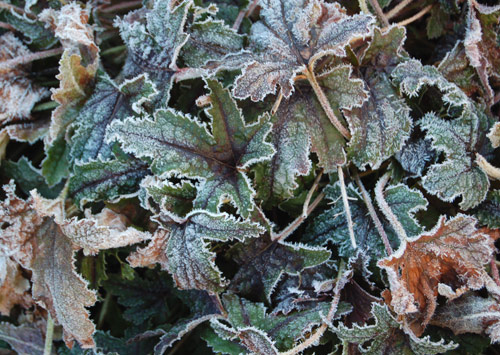 |
| Winter Foliage |
IN THE GARDEN
Heucherellas are essentially a shade groundcover. Pink to creamy-white flowers come forth from mid-spring (May here) to early summer with sporadic bloom afterwards into fall. They are relatively drought tolerant, but appreciate a summer watering. Even the most desiccated plant will surprise you by perking up soon after a watering. In fact the best way to kill a Heucherella is to overwater it or plant it in clay. The importance of drainage is paramount to happy plants! (This goes for Heuchera and Tiarella as well) Foliage varies greatly between cultivars, but there is a good enough selection to work with many other plants. Do note that the height some varieties top out at 10" and some can get up to 22", so pay attention to the description on the tag or in the catalog. Spread also varies from 12" for H. 'Dayglow Pink' to 30" for H. 'Kimono'. We mulch our beds yearly with bark, taking care that the crowns of the plants are not buried (another way to kill them!) They are evergreen in milder climates.
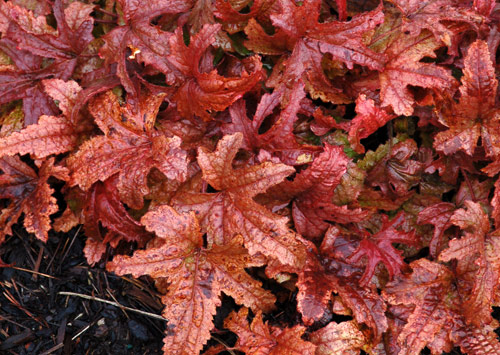
|
| Heucherella 'Kimono' (Fall) |
USES IN THE GARDEN
We feel that Heucherellas are "front and center" border plants, excellent near pathways and amongst the ferns and woodlanders. They are equally at home in a rock garden tolerating much more sun than you might imagine, but preferring afternoon shade if at all possible. Newer forms like H. 'Kimono', 'Alabama Sunrise' and 'Sweet Tea' are large enough that they can stand alone as a specimen or fill a container independently. Smaller, "flower-power" plants like H. 'Dayglow Pink' can make quite an impact when planted in large masses.
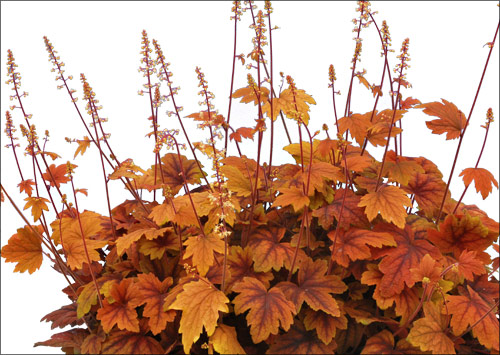
|
| Heucherella 'Sweet Tea' |
IN CONTAINERS/COMBINATIONS
We pulled a phrase from child's report card: Plays well with others. This describes the non-aggressive Heucherella. As you would not but aggressive fish in a tank with guppies, you should be careful about choosing the "rella's" companions in the pot. Use Sutera (Bacopa) instead of Ipoemea (Sweet Potato Vine). Mix with diminutive Astilbe, fine ivies, ferns and Hosta and you'll have a happy pot.
